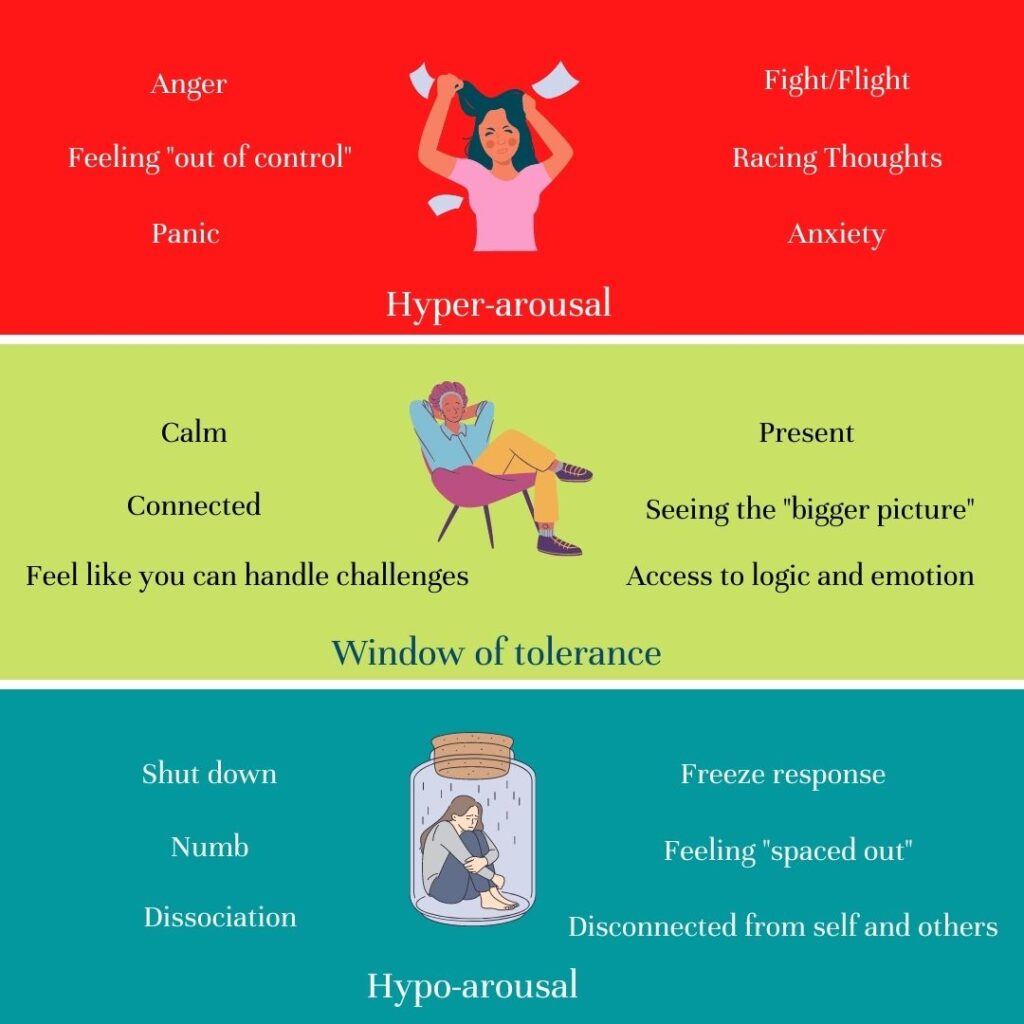Our bodies are deeply intelligent and geared for survival. In moments of crisis, this can help us to run, fight back, freeze or even check out completely. These are strategies of survival that are very adaptive when there is a real threat present. They allow us to maneuver and get through sometimes unthinkable circumstances.
When a person develops Post Traumatic Stress Disorder (PTSD), whether from a single incident trauma such as a car accident, or repeated, multiple traumas that can lead to Complex Post Traumatic Stress Disorder (C-PTSD), such as growing up with a parent with an addiction, these survival strategies start to come online even when there is no longer a threat present.
Trauma gets stored in our bodies and “stuck” in an over and/or under-active nervous system response. We become hyper-alert to possible threats, and continue to respond in ways that might seem incongruent with what’s happening in the present moment.
This can look like flashbacks, intrusive thoughts, avoidance of situations that are reminiscent of the trauma(s), dissociation and/or feeling completely cut off from our emotions. While talking about it can be helpful for building a cohesive understanding and narrative of the trauma(s), it is often only through accessing our body’s wisdom and innate healing capacities that full trauma recovery is possible.
When I work with folks who are in the beginning stages of trauma recovery, one of the first things I do is introduce them to the concept of the window of tolerance. The window of tolerance is the optimal state of arousal for our nervous system that allows us to function and thrive in daily life. When we are “outside” of our window of tolerance, we are either experiencing hyper or hypo-arousal.

Trauma narrows the window of tolerance that our minds and bodies have for tolerating distress, discomfort, challenging interpersonal situations and all of the other inevitable and often unexpected obstacles that life throws in our way.
A vital part of trauma recovery is to work toward widening the window of tolerance. This doesn’t mean an absence of stress and feeling happy and calm all of the time (although with a wider window of tolerance you will certainly have more access to positive emotions). Widening one’s window of tolerance means re-gaining trust in your body, a sense of safety, security and connection that is not reliant on being in full control of the external world.
So what can help a person widen their window of tolerance, an essential part of healing trauma?
It’s not uncommon to experience both hyper and hypo-arousal, but for the purposes of this blog post, I’ll break it down into two categories, what to do when you are in the “red” or above the window of tolerance (i.e. hyper-arousal) and what to do when you are in the “blue” or below the window of tolerance (i.e. hypo-arousal).
It’s important to know that the goal is not to never be in the “red” or the “blue” – it is very common in just a single morning to find yourself in all three zones. The difference between someone who is experiencing PTSD and someone who isn’t is that it’s often easier for the person who doesn’t have PTSD to come back into the “green” when a stressor does hit.
If you are spending a lot of time in the “red” or hyper-arousal zone, you might want to try:
- Moving your body: there’s a lot of energy and tension that’s coming up right now, and it can be helpful to honor your body’s need to shake or run or even hide for a moment (think finding a quiet room and closing your eyes if it feels safe)
- Noticing your surroundings: find grounding and bring yourself back to the present moment by bringing awareness to your physical surroundings. Engage all of your senses and notice what you see, hear, feel, taste and textures you can touch (grabbing something cold, like an ice cube can be particularly helpful)
- Riding the wave: when we are in the “red” and try to fight against it, that can often make it more intense. Know that this is temporary and that it will pass. You don’t have to like the feeling, but if you can create even a little more space for allowing it, often it will lessen in its intensity
- Slowing down your breathing: When we are in hyper-arousal, often our breath is short and shallow, and it’s not something that we notice and can shift unless we first bring awareness to it. See if you can intentionally slow down your breathing by inhaling and exhaling on a count of four
If you are spending a lot of time in the “blue” or hypo-arousal zone, you might want to try:
- Bringing gentle movement to your body: When your nervous system is in freeze or shut down response, you may feel lethargic, listless, and like the last thing you want to do is to move around. By introducing gentle and slow movement like stretching your hands up over your head or pressing your feet firmly into the ground, you’re offering nurturing and nourishing movement that can help ease the exhaustion and sense of not having any control.
- Calling a friend: When we’re in the “blue,” we often feel isolated and alone. You’ll want to be intentional about who you reach out to by asking what you’re looking for. Sometimes we just need someone to sit with us and meet us where we are without trying to change anything. Sometimes we need words of encouragement and hope.
- Watching a funny video: Laughter really can be the best medicine. Whether it’s a video of an animal doing something ridiculous or rewatching an episode of your favorite TV show, be sure to choose something that connects you to the more connected and joyful version of you.
- Putting on a playlist: Try making an iso-principle playlist that moves you from a place of shut-down to a place of greater connection, hope and energy. You can start with songs that speak to the sense of disconnection that you feel – perhaps the lyrics reflect this, and/or the speed and overall sound of the song. Then, slowly move toward songs that instill hope and a knowing that you are not alone.
Trauma is stored in our bodies, so it makes sense to work from the “ground up” to begin to establish or reestablish a greater sense of trust in ourselves. Trauma recovery is often not a straight path, and you don’t have to do it alone. Working with a qualified trauma therapist who offers somatic, body-based healing modalities can be a great place to start.




0 Comments